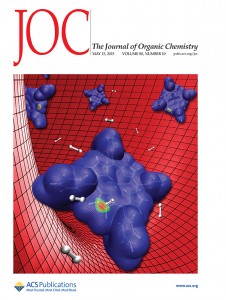A first collaborative paper with the Agrios Group, UConn Department of Civil and Environmental Engineering and Center for Clean Energy Engineering (C2E2) was published: Hewage, N.; Bowen; Agrios, A. G.; Brückner, C. ‘Introduction of Carboxylic Ester and Acid Functionalities to meso‑Tetrakis(pentafluorophenyl)porphyrin and their Limited Electronic Effects on the Chromophore’ Dyes Pigm. 2015, 121, 159–169.
Alkyl- or aryl-carboxylic acid-functionalized porphyrinic dyes are sought after because of their propensity to adhere strongly to many metal oxide surfaces as required for their application as, for instance, sensitizers in dye-sensitized solar cells (DSSCs), in air purification, or chemosensing systems. The SNAr reaction of the pentafluorophenyl group is a versatile method to introduce functionality into mesopentafluorophenyl- substituted porphyrins. The conditions to introduce one through four alkyl- or aryl-carboxyl functionalities using mercaptopropionate or 3,4-dihydroxybenzoate esters, respectively, are explored, and the regioisomeric products are spectroscopically characterized. Their saponification to the corresponding carboxylic acids was studied. By experimental determination of their optical properties (absorption and emission spectroscopy) and their frontier orbital positions by cyclic voltammetry, we demonstrate the minimal electronic influence this derivatization method has on the chromophore.
See also the Audioslide presentation of article.
